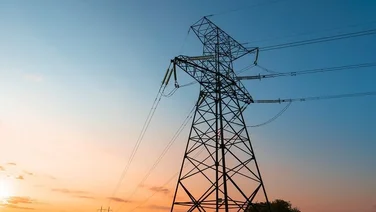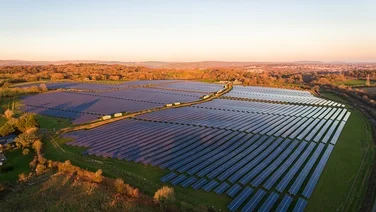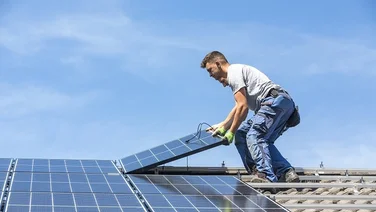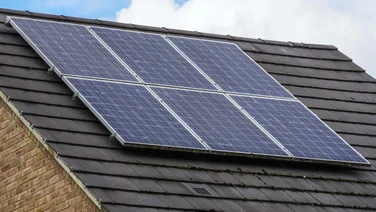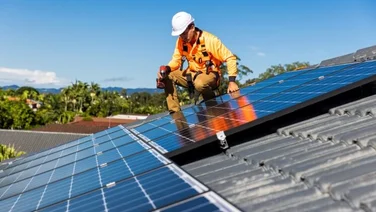- PPAs are a contractual agreement between energy suppliers and buyers
- There are seven different types of PPAs
- PPAs are a vehicle to help make renewable energy more accessible to consumers

A Power Purchase Agreement (PPA) is a contractual agreement between energy suppliers and buyers that enables the latter to invest in renewable energy without incurring the cost of installation, thereby reducing the amount of power generated from fossil fuels.
With the UK’s net-zero emissions goal by 2050, it’s more important than ever to invest in renewable energy. However, the reality is that many struggle with the costs, which is where PPAs can help.
In this guide, we walk you through the various PPAs available on the market, explain how they work when installing solar panels, and outline the pros and cons of using one.
What are PPAs?
A Power Purchase Agreement (PPA) is a long-term contract between a renewable energy generator and an energy buyer, often with a third-party intermediary involved in specific structures, such as virtual PPAs. They come together to buy and sell a certain amount of energy from renewable sources.
PPAs are usually signed for 10-25 years.
There are multiple types of PPAs, including physical PPAs, virtual (or synthetic) PPAs, and on-site versus off-site PPAs, each tailored to different risk tolerances, energy delivery preferences, and financial structures.
However, to benefit from PPAs, you will need a sufficiently large and consistent electricity demand, typically from solar PV or wind, and a suitable location. To this end, PPAs generally are the sole reserve of businesses and institutions.
To this end, small-scale consumers, such as homeowners, typically use solar leases, loans, or outright purchases with net metering, rather than innovative domestic-scale PPA-like services. But more on that later.
How do solar PPAs work?
According to Solar Energy UK, the producer or business arranges the design of a solar PPA before gaining the necessary permissions and managing the installation of a solar PV system on the customer’s property at little or no cost.
“While under contract, the customer receives a significantly reduced electricity tariff, offsetting the costs from their utility provider, while the developer receives income from the sale of the generated electricity,” the supplier said.
The PPA will outline the characteristics of the agreement, including negotiated prices and the quantity of electricity you require to be supplied. When the contract comes to an end, you can choose to remove the system, extend the PPA or purchase the energy system.
It’s also worth noting that your solar power will be generated in precisely the same way as it would be if you bought it without a PPA – the difference is in how you pay for it. The exact PPA process will likely differ depending on the supplier you choose.
Who uses PPAs in the UK?
According to a press release from Geo Green Power, Power Purchase Agreements have become an increasingly popular way for UK businesses to access solar energy without the burden of upfront capital investment.
High-profile companies such as Tesco and Amazon now rely on solar PPAs for up to 75% of their energy needs, demonstrating the scalability and financial appeal of these contracts. Under these kinds of PPA, the solar installation is funded by a third-party provider, with the business agreeing to purchase the generated electricity at a rate lower than the standard grid energy rate.
The provider remains responsible for all maintenance, servicing, and system performance. PPAs typically span 10 to 15 years and offer fixed pricing, which shields businesses from energy market volatility while delivering predictable savings.
Importantly, PPAs also help businesses track and reduce Scope 2 emissions, enhance their EPC ratings, and fulfill their sustainability reporting obligations.
For companies with multiple sites, a PPA provides a low-risk opportunity to trial solar at one location. If the results are favourable, they can scale to additional sites without incurring upfront installation costs.
Once the agreement ends, the business may choose to renew, terminate, or purchase the solar system outright.
What are the benefits of PPAs?
PPAs can be a more cost-effective option for you to install solar panels, and there’s also additional benefits, too:
- No upfront costs – With a PPA, there are no upfront costs to install solar panels, as you’re installing them on a lease. This option could save you up to £10,000.
- Cheaper rates – Businesses work hard to negotiate prices on renewable energy, so it’s likely you’ll pay less rates than if you installed them with a PPA.
- Maintenance is low – Depending on your PPA, you won’t need to worry about maintenance and insurance, as this will be covered by the company you partner with.
- Home value increase – Installing solar panels can help increase the value of your home. What’s more, any PPA you have can be transferred to the new occupants if you decide to sell.
- Flexible options – When you reach the end of your PPA, there are flexible options for ownership to either sign a new agreement or buy the solar panel system you’ve installed.
What are the cons of PPAs?
Like most things, there are drawbacks to having a PPA:
- PPAs are complex – Like most legal documents, PPAs are long and use complex language. The process can also take a long time.
- Penalties – PPA contracts can incorporate quite stiff penalties if you need to cancel the PPA before the contract ends.
- Control – Homeowners can have little-to-no control on the materials they install, but this is dependent on the aforementioned PPAs, requirements and the companies you work with.
- Selling issues – While you can transfer your PPA to new occupants if you sell your home, the new occupants must first agree to it. If they aren’t interested, it can be a struggle to sell your home.
- Variable rates – While businesses will negotiate lower pricing, you will likely be on a variable rate over a fixed one, meaning you’re vulnerable to other price increases.
Who are PPAs for?
While PPAs are primarily designed for businesses, institutions, and industrial-scale users due to the scale, duration, and credit requirements, some solar providers now offer homeowner-accessible versions.
These often take the form of residential solar PPAs, leases, or hybrid agreements that mimic PPA structures, particularly in regions with strong solar markets and consumer protections.
In the UK, residential PPAs remain a niche market. However, newer market models and tech advances are lowering barriers.
Providers like Octopus Energy and other green tech firms are beginning to offer shared rooftop models or neighbourhood solar PPAs, potentially allowing private consumers to benefit from pooled generation without owning the infrastructure outright.

What kinds of solar PPAs are there?
There are seven kinds of PPAs and the right one will depend on what you need. We’ll go into more detail in which one below, but the different PPAs available are:
- On-site PPA
- Off-site PPA
- Sleeved PPA
- Physical Delivery PPA
- Portfolio PPA
- Block Delivery PPA
- Virtual PPA
On-site PPAs
On-site solar PV generation can take the form of either a large-scale rooftop installation on a commercial or industrial site, according to Solar Energy UK, or on a ground-mount installation on adjacent land.
“It is also possible for C&I energy consumers to contract directly with a nearby renewable generator via a private wire arrangement,” its website said. “But these arrangements are more complex and remain relatively rare. By their very nature, on-site PPA structures are location and situation specific”.
To be successful, most on-site PPAs with solar PV should cover the following:
- The consumers’ electricity demand must be sufficiently large, consistent and time-matched for solar PV
- A suitable location must be available to host the site, either on-site or nearby. At least 1 square metre of space would be needed per kW of solar PV energy, but this will vary
- An affordable connection to the local distribution grid
- You’ll need to undergo credit checks and be deemed creditworthy to facilitate any financing
Off-site PPAs
Off-site PPAs allow businesses to access renewable energy from external projects located off premises, and you’re able to connect to the largest solar farms across the UK.
This type of PPA offers businesses flexibility and scalability in meeting renewable energy companies or utility providers.
Choosing an off-site PPA can enable your business to enter into a long-term contract for solar energy, without the need for too much installation disruption.
Sleeved PPAs
A sleeve PPA utilises a third-party intermediary, which is also known as a ‘sleeve’, to help facilitate the physical delivery of electricity from a renewable source to the buyer.
The third-party client then helps businesses navigate regulatory complexities, ensuring a reliable power supply from renewable sources.
“In a sleeved PPA arrangement, the sleeve acts as a bridge between the renewable project and the buyer, managing the physical delivery of electricity, while the buyer benefits from renewable energy, without directly engaging in energy transactions,” Novergy Solar said.
The benefit of a sleeved PPA for businesses is that it provides them with a more streamlined approach to accessing renewable energy, resulting in less administrative work on their end and ensuring compliance with regulations.
Physical Delivery PPAs
With a physical delivery PPA, the clue is the name. The buyer directly receives the electricity produced by a renewable energy project.
A physical delivery PPA offers straightforward ownership of the power, providing businesses with a clear and direct method to acquire renewable energy, such as solar, and integrate it into their energy portfolio.
Choosing this PPA offers more transparency and accountability than other PPAs on the market, as it ensures you receive your expected energy output from your renewable energy projects.
Portfolio PPAs
Portfolio PPAs offer multiple renewable energy projects to fulfil the buyer’s energy requirements, speaking to energy sources across each project you’re working on.
This also reduces overall risk.
Combining all your projects with the portfolio PPA offers more reliability and stability in energy supply, even in the face of fluctuations.
With a PPA, you’re able to access solar, wind and hydroelectric power, offering greater flexibility, allowing you to reach your sustainability goals sooner.
Block Delivery PPAs
Block delivery PPAs enable buyers to purchase energy in predetermined blocks, providing some flexibility in meeting energy demands. This allows you to adjust your energy requirements to your specific needs at that moment in time.
By utilising these blocks, you have a greater opportunity to effectively manage costs and relieve any budgeting constraints that may arise.
This type of PPA offers a more structured approach to energy procurement, providing transparency and predictability in energy pricing.
Virtual PPAs
Virtual PPAs allow organisations to purchase the environmental attributes of renewable energy generation, without physically receiving the electricity.
In essence, this enables organisations to support renewable energy projects and meet their sustainability goals without requiring direct solar energy consumption. This option offers wide environmental benefits while helping to mitigate the risks associated with traditional energy sources.
Most companies will need to conduct a risk assessment before signing a virtual Power Purchase Agreement (PPA) to gain a better understanding of their goals and risk tolerance.
This is a suitable option for businesses seeking to expand their use of renewable energy.
Which PPA should I buy?
The type of PPA you will need will vary depending on your needs and location. For example, if you’re located in an urban area with little space, an off-site PPA will be better.
Whereas if you’re somewhere outside a city with lots of space, an on-site PPA could be better. Whatever your location, you should consider all your options based on how much you want to spend.
For most domestic consumers, a PPA isn’t generally viable. That said, homeowners can still access solar in other ways:
- Solar Leases – Fixed monthly payments for using the panels, but you don’t own them.
- Solar Loans – Finance the purchase with complete ownership and long-term savings.
- Outright Purchase – High upfront cost, but most significant return over time.
- Net Metering – Sell excess power back to the grid for credits (where available).
Each option suits different levels of budget, control, and commitment.

Solar PPA vs solar panel lease
A solar PPA and a solar panel lease work in very similar ways. In both cases, a solar company installs, maintains and owns the system that produces solar energy. The difference, however, is what you’ll pay.
A PPA offers you a variable rate based on your energy usage, whereas a solar panel lease offers a fixed rate. Therefore, you need to decide which is more practical and financially viable for you. Variable rates come with risk, and you could make more or less than your initial payments.
Summary
- Power Purchase Agreements (PPAs) provide a cost-effective means of accessing renewable energy without requiring upfront investment.
- Businesses most commonly use them, but they are gradually becoming more accessible to homeowners through tailored plans.
- PPAs offer long-term energy price stability, enabling buyers to avoid market volatility.
- With no installation or maintenance burden, users benefit from professional system management throughout the contract.
- There are multiple PPA types available to suit different needs, from on-site installations to virtual agreements.
- As the UK accelerates toward net-zero targets, PPAs are playing a key role in expanding access to clean, affordable energy.


